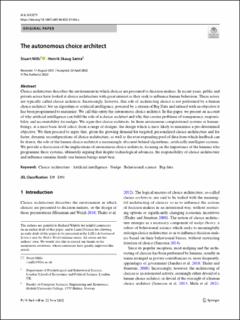| dc.description.abstract | Choice architecture describes the environment in which choices are presented to decision-makers. In recent years, public and private actors have looked at choice architecture with great interest as they seek to influence human behaviour. These actors are typically called choice architects. Increasingly, however, this role of architecting choice is not performed by a human choice architect, but an algorithm or artificial intelligence, powered by a stream of Big Data and infused with an objective it has been programmed to maximise. We call this entity the autonomous choice architect. In this paper, we present an account of why artificial intelligence can fulfil the role of a choice architect and why this creates problems of transparency, responsibility and accountability for nudges. We argue that choice architects, be them autonomous computational systems or human-beings, at a most basic level select, from a range of designs, the design which is most likely to maximise a pre-determined objective. We then proceed to argue that, given the growing demand for targeted, personalised choice architecture and for faster, dynamic reconfigurations of choice architecture, as well as the ever-expanding pool of data from which feedback can be drawn, the role of the human choice architect is increasingly obscured behind algorithmic, artificially intelligent systems. We provide a discussion of the implications of autonomous choice architects, focusing on the importance of the humans who programme these systems, ultimately arguing that despite technological advances, the responsibility of choice architecture and influence remains firmly one human beings must bear. | en_US |

